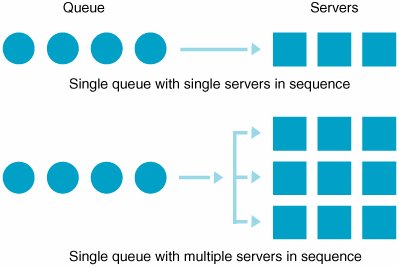Additional Types of Queuing Systems
| The single queue with a single server and the single queue with multiple servers are two of the most common types of queuing systems. However, there are two other general categories of queuing systems: the single queue with single servers in sequence and the single queue with multiple servers in sequence . Figure 13.4 presents a schematic of each of these two systems. Figure 13.4. Single queues with single and multiple servers in sequence(This item is displayed on page 599 in the print version) An example of a queuing system that has a single queue leading into a sequence of single servers is the personnel office of a company where job applicants line up to apply for a specific job. All the applicants wait in one area and are called alphabetically . The application process consists of moving from one interview to the next in a single sequence to take tests, answer questions, fill out forms, and so on. Another example of this type of system is an assembly line, in which products are queued up prior to being worked on by a sequenced line of machines. If, in the personnel office example, an extra sequence of interviews were added, the result would be a queuing system with a single queue and multiple servers in sequence. Likewise, if products were lined up in a single queue prior to being worked on by machines in any one of three assembly lines, the result would be a sequence of multiple servers. These are four general categories of queuing systems. Other items that can contribute to the variety of possible queuing systems include the following:
|
EAN: 2147483647
Pages: 358
